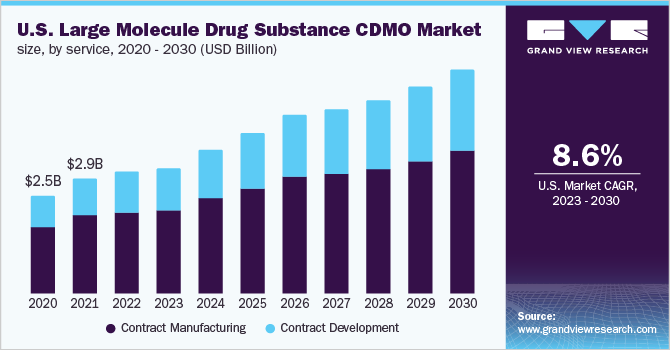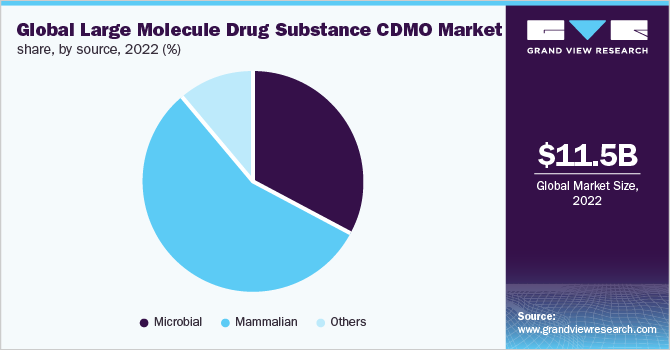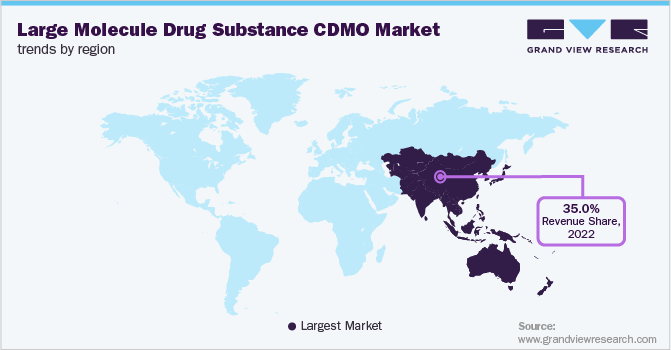- Home
- »
- Medical Devices
- »
-
Large Molecule Drug Substance CDMO Market Report, 2030GVR Report cover
![Large Molecule Drug Substance CDMO Market Size, Share & Trends Report]()
Large Molecule Drug Substance CDMO Market Size, Share & Trends Analysis Report By Service (Contract Manufacturing, Contract Development), By Source, By End-user, By Region, And Segment Forecasts, 2023 - 2030
- Report ID: GVR-4-68039-946-2
- Number of Report Pages: 145
- Format: PDF, Horizon Databook
- Historical Range: 2018 - 2021
- Forecast Period: 2023 - 2030
- Industry: Healthcare
Report Overview
The global large molecule drug substance CDMO market size was valued at USD 11.5 billion in 2022 and is expected to expand at a compound annual growth rate (CAGR) of 9.3% from 2023 to 2030. Increasing large molecule drug approvals, primarily with the FDA, rising incidence of infectious diseases, high demand for novel therapeutics, and higher capital investments by pharma and biotech firms in advanced technologies for establishing partnerships with CDMOs are the key factors driving the market. Large molecule drug investment was increasing prior to the COVID-19 pandemic as it offers a plethora of new treatment options. During the race to develop therapeutics and vaccines against the SARS-CoV-2 virus, the value of biologics became even more evident. The demand for both high-volume and high-quality CGMP drug substance and drug product manufacturing services has risen dramatically, especially for CDMOs capable of providing a broad range of COVID vaccine technologies and, to a smaller extent, therapeutic monoclonal antibody products.

However, in order to combat the pandemic, new technologies were adapted and implemented in distribution logistics, vaccine production, monoclonal antibody manufacturing, and diagnostic testing. The pandemic highlighted the importance of more local, US-based contract pharma services, and intimately aligning academia, manufacturers, drug innovators, and regulatory agencies to deliver treatments to patients. As CDMOs race to generate COVID-19-related therapies in 2021, large molecule (drug substance and drug product) production capacity and supply chain would then remain constrained.
Large molecules drug development is separated into two sections: drug substance (DS) development, which involves the development of master and working cell banks, manufacturing process development, and scale-up, and drug product (DP) development, which includes the filling of the drug substance into the primary container. The International Council for Harmonization of Technical Requirements for Pharmaceuticals for Human Use (ICH), like all regulatory authorities, provides some level of guidance regarding the characterization and measurement of drug performance and quality. ICH Q6 is concerned with establishing specifications for both DS and DP for new chemical entities.
Developing a large molecule drug substance that is both effective and safe while also keeping costs and development time under control is a difficult task. Due to the complexity and fragility of large molecule active compounds, formulation development faces a host of difficulties. Overcoming difficulties and meeting deadlines have become key drivers for CDMOs in the early stages of drug development. There are numerous innovative technologies available to drug developers that aid in stabilization and can protect the large molecule drug substance, such as encapsulation and the use of buffers.
Service Insights
The contract manufacturing segment dominated the market and accounted for a revenue share of over 65.0% in 2022. This segment is further divided into target identification and screening, target validation and functional informatics, lead identification and candidate optimization, and preclinical development. Indian pharmaceutical companies have extensive experience in contract manufacturing, and recent quality-control scrutiny is driving significant improvements in manufacturing standards.
The contract development segment is expected to expand at the fastest CAGR of 10.9% over the forecast period. The segment is further divided into cell line development and process development. The top CDMOs provide services for large molecules including upstreaming processing and down streaming processing and a portfolio of analytical methods for protein characterization and bioassays.
End-user Insights
In 2022, biotech companies held the largest revenue share of over 40.0%. This can be attributed to increased R&D investments in the biopharmaceutical sector as well as an increase in diseases for which biotech companies are conducting extensive research. In addition, biotech firms are using mergers and acquisitions, regional expansion, product/service portfolio expansion, and competitive pricing as key strategies to stay competitive and gain a larger market share.
The others segment is expected to expand at the fastest CAGR of 10.7% over the forecast period. It includes pharma companies, government research institutes, and academic institutes. Traditionally, pharmaceutical companies focused on small molecules, whereas biotechnology firms focused on large molecules but now big pharma companies are more concerned with large than small molecules.
Source Insights
The mammalian source segment dominated the global market and accounted for a revenue share of more than 55.0% in 2022. The mammalian segment is estimated to expand at the fastest rate over the forecast period. This category will expand as more complex biologics, such as bi- and tri-specific antibodies, and antibody-drug conjugates are evolved. mAbs and their synthetic equivalents have received significant funding due to their effectiveness in treating a variety of diseases, including cancer. mAbs have traditionally been created from mammalian therapies to treat diseases such as these.

The microbial source segment is anticipated to register the second-fastest CAGR during the forecast period. Microbial systems are widely used for producing recombinant proteins for therapeutic purposes. Around 650 protein drugs have been approved worldwide to date, among which about 400 were obtained from microbial recombinant technologies. Moreover, approximately 1/3 of biologics approved for manufacturing are produced by microbial sources, which are primarily used by CDMOs to produce cytokines, hormones, enzymes, and MABs. These factors are supporting segment growth.
Regional Insights
Asia Pacific held the largest revenue share of over 35.0% in 2022 and is projected to register the fastest CAGR over the forecast period. A large patient base, lower overall costs, a skilled workforce, and changes in the regulatory scenario are the key factors driving the regional market growth. The region is seen as the most appealing for contract manufacturing. Asia Pacific countries have a sizable patient base and the potential for highly skilled medical professionals. The cost of manufacturing and running a clinical trial is considerably low compared to western countries. Additionally, companies such as Boehringer Ingelheim and Wuxi Biologics are continually working to extend their services in this region. For instance, in November 2020, Wuxi Biologics launched a biologics integrated innovation center in Hangzhou, Zhejiang province, China. This center will provide a wide range of services from process development to manufacturing. These aforementioned factors are expected to contribute to the regional market growth.

North America is expected to witness growth in the years to come due to large R&D investments in the U.S. For instance, the Pharmaceutical Research and Manufacturers of America reported in 2022 that American pharmaceutical companies spent $102.3 billion on R&D in 2021, of which 79.6 billion were spent domestically and 22.7 billion were spent overseas. As of September 2022, the USFDA had approved 39 biosimilar drugs. Furthermore, the presence of a large number of players such as Catalent, Cambrex Corporation, LabCorp Drug Development, and Fujifilm Diosynth Biotechnologies drives the market. For instance, in April 2022, Catalent announced a multi-year investment worth USD 350 million at its Bloomington, Indiana facility to broaden large molecule drug product and drug substance manufacturing capabilities.
Key Companies & Market Share Insights
Mergers, acquisitions, and partnerships were the key strategies adopted by key players to maintain their market share. For instance, in September 2022, FUJIFILM Diosynth announced the expansion of its large-scale microbial manufacturing facility in Billingham, U.K. This expansion will be done on the 1858 square meter (20,000 sq. ft.) area and will accommodate the growing demand for microbial development and manufacturing. Some prominent players in the global large molecule drug substance CDMO market include:
-
Eurofins Scientific
-
WuXi Biologics
-
Samsung Biologics
-
Catalent, Inc.
-
Rentschler Biopharma SE
-
AGC Biologics
-
Recipharm AB
-
Siegfried Holding AG
-
Boehringer Ingelheim
-
FUJIFILM Diosynth Biotechnologies
Large Molecule Drug Substance CDMO Market Report Scope
Report Attribute
Details
Market Size value in 2023
USD 11.9 billion
Revenue forecast in 2030
USD 22.1 billion
Growth rate
CAGR of 9.3% from 2023 to 2030
Base year for estimation
2022
Historical data
2018 - 2021
Forecast period
2023 - 2030
Quantitative units
Revenue in USD million/billion and CAGR from 2023 to 2030
Report coverage
Revenue forecast, company ranking, competitive landscape, growth factors, and trends
Segments covered
Service, source, end-user, region
Regional scope
North America; Europe; Asia Pacific; Latin America; Middle East & Africa
Country scope
U.S.; Canada; U.K.; Germany; France; Italy; Spain; Denmark; Sweden; Norway; Japan; China; India; Australia; Thailand; South Korea; Brazil; Mexico; Argentina; South Africa; Saudi Arabia; UAE; Kuwait
Key companies profiled
Eurofins Scientific; WuXi Biologics; Samsung Biologics; Catalent, Inc.; Rentschler Biopharma SE; AGC Biologics; Recipharm AB; Siegfried Holding AG; Boehringer Ingelheim; FUJIFILM Diosynth Biotechnologies
Customization scope
Free report customization (equivalent up to 8 analysts working days) with purchase. Addition or alteration to country, regional & segment scope
Pricing and purchase options
Avail customized purchase options to meet your exact research needs. Explore purchase options
Global Large Molecule Drug Substance CDMO Market Segmentation
This report forecasts revenue growth at the global, regional, and country levels and provides an analysis of the latest industry trends and opportunities in each of the sub-segments from 2018 to 2030. For the purpose of this study, Grand View Research has segmented the global large molecule drug substance CDMO market report on the basis of service, source, end-user, and region:

-
Service Outlook (Revenue, USD Million, 2018 - 2030)
-
Contract Manufacturing
-
Clinical
-
Commercial
-
-
Contract Development
-
Cell Line Development
-
Process Development
-
-
-
Source Outlook (Revenue, USD Million, 2018 - 2030)
-
Mammalian
-
Microbial
-
Others
-
-
End-user Outlook (Revenue, USD Million, 2018 - 2030)
-
Biotech Companies
-
CRO
-
Others
-
-
Regional Outlook (Revenue, USD Million, 2018 - 2030)
-
North America
-
U.S.
-
Canada
-
-
Europe
-
U.K.
-
Germany
-
France
-
Italy
-
Spain
-
Denmark
-
Sweden
-
Norway
-
Rest of Europe
-
-
Asia Pacific
-
JapanChina
-
India
-
Australia
-
Thailand
-
South Korea
-
Rest of Asia Pacific
-
-
Latin America
-
Brazil
-
Mexico
-
Argentina
-
Rest of Latin America
-
-
Middle East & Africa
-
South Africa
-
Saudi Arabia
-
UAE
-
Kuwait
-
Rest of Middle East and Africa
-
-
Frequently Asked Questions About This Report
b. The global large molecule drug substance CDMO market size was estimated at USD 11.5 billion in 2022 and is expected to reach USD 11.9 billion in 2023.
b. The global large molecule drug substance CDMO market is expected to grow at a compound annual growth rate of 9.3% from 2023 to 2030 to reach USD 22.1 billion by 2030.
b. Asia Pacific dominated the large molecule drug substance CDMO market with a share of 35.5% in 2022. Large patient base, lower manufacturing costs, skilled workforce, and changes in the regulatory scenario are the key factors driving the market growth in this region.
b. Some key players operating in the large molecule drug substance CDMO market include Eurofins Scientific, WuXi Biologics., Samsung Biologics, Catalent, Inc, Rentschler Biopharma SE, AGC Biologics, Recipharm AB, Siegfried Holding AG, Boehringer Ingelheim, and FUJIFILM Diosynth Biotechnologies
b. Key factors are the increasing large molecule drug approvals, primarily with the FDA, rising incidence of infectious diseases, and high demand for novel therapeutics, as well as higher capital investments by pharma and biotech firms in advanced technologies for establishing partnerships with CDMOs, are the key factors driving market growth.
Share this report with your colleague or friend.
![gvr icn]()
NEED A CUSTOM REPORT?
We can customize every report - free of charge - including purchasing stand-alone sections or country-level reports, as well as offer affordable discounts for start-ups & universities. Contact us now
![Certified Icon]()
We are GDPR and CCPA compliant! Your transaction & personal information is safe and secure. For more details, please read our privacy policy.
We are committed towards customer satisfaction, and quality service.
"The quality of research they have done for us has been excellent."





